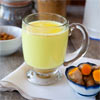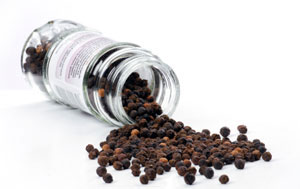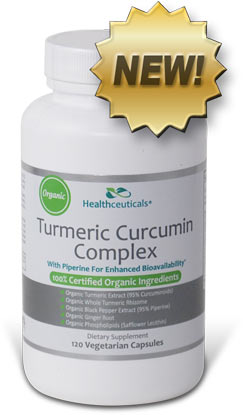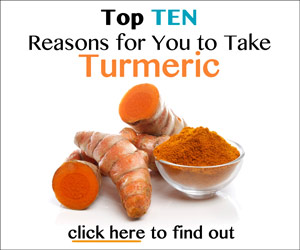Turmeric: More than Just a Spice

Turmeric is most commonly known as a spice from the ginger plant family. To make the familiar powdered spice, the rhizomes from turmeric are harvested, boiled, dried, and then ground. In addition to flavor, the bright or golden yellow spice adds color to traditional curry recipes, mustards, and cheeses. (i.1, 2)

Besides dried turmeric, herbal medicines also use fresh, green turmeric rhizomes and leaves. Recent research confirms they have potential as natural pesticides, fungicides, and potent insect repellants. For example, studies show that turmeric oils and extracts offered 100% protection for nine hours against mosquito and black fly bites. (i.1-3)
Types of Turmeric
There are many different species of turmeric. The most commonly used is Curcuma longa, also known as Curcuma domestica. The two main varieties of the C. longa species are Alleppey and Madras. Alleppey is preferred in the United States. It is much higher in turmeric's most-studied bioactive compound (curcumin) than Madras—the favorite variety in Great Britain and the Middle East. Widely cultivated, you can grow turmeric in a home garden. There are also related species and varieties that grow in the wild. (i.1, 4)
Turmeric - In The News
-

Can Turmeric Cure Blood Cancer?
A woman in London who had unsuccessfully battled myeloma blood cancer with chemotherapy and stem cells turns to turmeric as a last resort. What happened?»read more
-

Worried about a high-fat diet?
A recent clinical trial shows that adding turmeric to a high calorie meal can significantly reduce the negative effects of a high-fat diet.»view study
-

Turmeric Cream for Breast Cancer
Can a skin cream help prevent radiation side effects?»read more
-

Natural Treatment for Brain Cancer
Recently published clinical study results suggest curcumin may be helpful in treating the most common type of brain cancer.»read article
-

Can Turmeric Help Prevent or Reverse Alzheimer's Disease?
According to researchers at UCLA, turmeric compounds can help improve memory and mood. Find out about the latest clinical trial results!.»view article
View News Archive
History of Turmeric
People have used turmeric as a spice, in cosmetics, as a yellow dye, and for many herbal remedies for thousands of years. Turmeric's popularity was widespread throughout Asia, India, the Middle East, and Greece. Historians and archaeologists have traced references and evidence of the plant over the centuries. These include: (i.1, 5, 6)
- The explorer Marco Polo wrote about turmeric. He referred to it as a plant growing in China that was similar in color to saffron—which may be why medieval people called it Indian saffron.
- An Assyrian text about herbs mentions turmeric around 600 BC.
- The famous ancient Greek physician Dioscorides listed turmeric as a medicinal plant.
In various cultures, turmeric was regarded as an integral part of the social structure itself. The herb was so woven into the fabric of daily life that it was the subject of many songs and poems. On the Polynesian island of Tikopia, for example, the indigenous people incorporated turmeric into wide-ranging areas of life, including: (i.7)
- Using turmeric pigment to decorate the face and arms and as a cloth dye for skirts worn in traditional dances.
- Mourners sprinkled turmeric on the clothes of the dead at funerals before burial.
- Conversely, when mixed with coconut oil, turmeric was used to release family members from mourning before dance festivals.
- Dried, ground rhizome made a flour base for pudding dishes.
- Turmeric leaves were fringed and tied into ritual necklaces.
While the exact origin of turmeric is unknown, it is probable that the C. longa species originated in the country once called Cochin China. Even if not originally from India, turmeric has and continues to be an important part of Indian industry and culture, and most of the world's turmeric is still grown there today. (i.1, 5)
Turmeric is Packed with Powerful Antioxidant Compounds
Turmeric is full of potent biochemical compounds called polyphenols, as well as vitamins, and minerals. Many of these are known to be powerful natural antioxidants. For example, turmeric contains one of the most well-known antioxidants—resveratrol—for its many health benefits. These include the possibility of preventing neurodegenerative conditions associated with aging (such as Alzheimer's disease). (i.8-13)
What Are Free Radicals and Antioxidants?
Generally speaking, free radicals are reactive molecules that contain oxygen atoms with unpaired electrons. Having an unpaired electron makes them unstable. An oxygen atom with an unpaired electron can also be a free radical. Free radicals are naturally produced as byproducts of many biological processes in the body. (i.15, 16)
But free radicals can be dangerous because they steal electrons from other atoms in the body in order to stabilize themselves. This process is called oxidation. So when a substance is oxidized, it has an electron stolen from it. Oxidation by free radicals transforms stable atoms into new free radicals—damaging cells and possibly causing disease. (i.15, 16)
However, we also make natural antioxidants to keep free radicals in check. Antioxidants can give up an electron to stabilize free radicals—without turning into free radicals themselves. (i.15, 16)
Understanding Oxidation—Free Radicals and Antioxidants
Turmeric's primary bioactive constituents are believed to be the antioxidant pigments that give turmeric rhizomes their color. Called curcuminoids, the three main pigments are curcumin, demethoxycurcumin, and bisdemethodycurcumin. Scientists have discovered many potentially valuable applications of these fat-soluble compounds in modern medicine, skin products, and insect control. In fact, curcumin is about 10 times more powerful as an antioxidant than vitamin E and about twice as potent as resveratrol. Animal studies show it is strong enough to counteract or prevent damage even from toxic metals. (i.8-16)

Using Turmeric
There are many ways to take advantage of all the naturally healthy benefits of this golden herb. To maximize its benefit, we provide lots of information on how to incorporate turmeric into your everyday life—from child-safe play dough to homemade acne remedies. Probably the easiest way is to use turmeric as a spice. Besides adding it to your favorite curry, both the dried rhizome spice and the fresh leaves can be used in many culinary recipes.
Combine turmeric powder with black pepper and olive oil in order to maximize its herbal anticancer, antioxidant, and anti-inflammatory benefits. A general rule of thumb for cooking ratios is: (i.17)
- ¼ teaspoon turmeric powder
- ½ teaspoon olive oil
- Ample pinch of black pepper
Turmeric and curcumin are also included as ingredients in a number of commercial herbal products, including: (i.3-5)
- Natural insecticides and pesticides
- Cosmetic and skin care products (such as in face cream, sunscreen, and hair removal products)
- Herbal supplement form (either whole turmeric or curcumin)
Join the 1000s of People Who Are Discovering the Benefits of Turmeric.

Healthceuticals® Turmeric Curcumin Complex
100% Certified
Organic ingredients
- Organic Turmeric Extract - standardized to 95% curcuminoids.
- Organic Whole Turmeric - provides full spectrum antioxidant, anti-inflammatory turmeric benefits, including turmerones and numerous vitamins, minerals, and phytonutrients
- Organic Black Pepper Extract - standardized to 95% piperine; dramatically enhances bioavailablity.
- Organic Phospholipids - markedly improve absorption.
- Organic Ginger - works synergistically with turmeric to provide more powerful benefits.
- Absolutely FREE of potentially harmful additives and fillers such as magnesium stearate.



